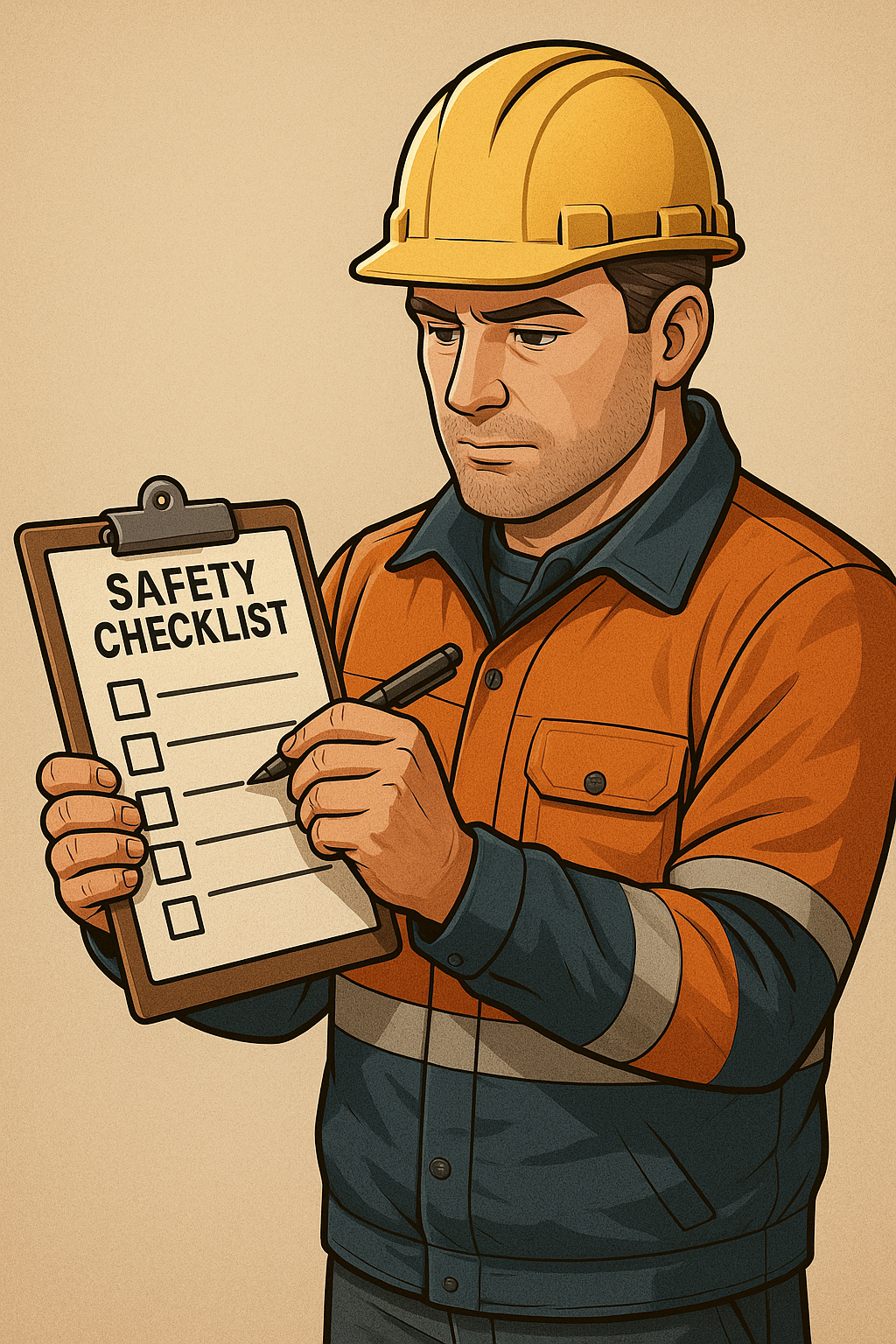
Daylight Saving = Safety Checkpoint
Use the time change to drive inspections, alarm tests and process reviews
When the clocks spring forward or fall back, most people focus on adjusting their watches and maybe changing the batteries in a smoke alarm. But for safety pros, that biannual time change signals something far more strategic: a natural safety‑checkpoint. It’s an ideal time to pause, inspect, test, review and reset key parts of your EHS program so you go into the next six months with greater confidence. Treat the time change like a built‑in reminder — and you’ll turn a simple administrative check‑in into a meaningful safety ritual.
Here’s how to make the most of the time‑change safety checkpoint — and why doing so enhances your credibility, protects your workforce, and builds stronger processes.
1. Why the time change matters for safety
It may seem mundane, but the time change carries real safety implications. For example, the National Institute for Occupational Safety and Health (NIOSH) notes that the abrupt shift in clocks can disrupt sleep and circadian rhythms, causing decreased alertness, increased risk of error and even higher driving‑incident risk in the days after the change. (Daylight savings: How Changes to Sleep Can Impact
Your Health and Safety - https://www.hse-network.com/daylight-savings-how-changes-to-sleep-can-impact-your-health-and-safety/ )
Another article reports that changes in lighting conditions (e.g., the afternoon rush suddenly in dusk instead of daylight) and fatigue may contribute to workplace or road‑incident risk. (Daylight Saving: Suggestions to Help Workers Adapt to the Time Change - https://blogs.cdc.gov/niosh-science-blog/2016/03/09/daylight-savings/ )
In short: the time change can serve as an early‑warning signal of shifting hazards — and that’s precisely why it’s a great time to pause and check your systems.
2. Make the inspection/audit list before you flip the clock
Here’s a practical list of checks you and your team should run — treat this like a mini audit or “reset” moment:
● Alarm systems & batteries: Smoke alarms, CO detectors, fire‑alarm control panels — check them now. For example, one state emergency management agency reminded citizens that when DST ends is a perfect time to check smoke/CO alarms and extinguishers. (Take Time to Stay Safe When Daylight Saving Time Ends - https://wem.wi.gov/ready231101/ )
● Lighting & visibility: The shift to darker mornings or earlier evenings affects facility lighting, exterior lighting, pedestrian walkways, vehicle routes and yard operations.
● Emergency procedures and drills: Confirm that emergency‑response plans reflect the changing hours (e.g., evacuation routes in dusk vs daylight), confirm communication systems, confirm alarm‑response times.
● Equipment & machinery: Machinery that runs in darker conditions or outside daylight hours may require adjustments (lighting, signage, guard visibility) now that shift patterns or daylight hours are different.
● Vehicle/fleet operations: Drivers may be operating in darker conditions earlier or later; this is a perfect time to check driver safety programs, retrain for dusk/dawn driving and ensure telematics and monitoring systems are ready.
● Worker fatigue & scheduling: Because of the time shift, workers may be dealing with less sleep, altered routines or lower alertness — the time change triggers an opportunity to remind supervisors and workers of fatigue risk.
By consciously scheduling these checks around the time change, you convert what might be “just another task” into a purposeful safety moment.
3. Embed the ritual into your safety culture
To truly leverage this checkpoint, make it part of your culture — not just “something we do because the clocks changed”. Here’s how:
● Promote awareness: In the week leading up to the time change, send communications (email, toolbox talk, bulletin board) reminding people of upcoming checks and tying it to safety culture (“we set our clocks, let’s check our systems”).
● Include the team: Get operations, facilities, maintenance, fleet/transport, EHS all engaged. The time change affects many areas; a cross‑functional check strengthens relationships and reveals blind spots.
● Document & follow up: Treat the time change check like an audit: complete a checklist, log findings, assign corrective actions and schedule follow‑up. Having documentation bolsters your program’s maturity.
● Use the moment for training/refresh: A short training module or safety moment tied to the time change can remind workers about fatigue, driving hazards, dusk/dawn visibility, equipment checks, etc.
● Make it visible: Use the clock‑change moment in safety signage, posters, intranet banners, local stand‑down to reinforce why the check‑in matters.
4. Align with broader EHS strategy & compliance
Beyond the immediate checklist, the time change safety checkpoint ties into broader elements of your EHS strategy:
● Regulatory readiness: Many regulatory frameworks expect periodic inspections, alarm testing, emergency‑plan reviews and training refreshers. The time‑change moment gives you a concrete date to align with those obligations.
● Leading indicator storytelling: Rather than waiting for an incident, use the time‑change check as a leading indicator — here’s what we did ahead of a known hazard trigger (changing light, altered schedules). That strengthens your safety narrative to leadership.
● Risk management: The time change inherently shifts risk (e.g., less daylight, altered worker alertness, different traffic conditions). By associating your safety check‑in with that shift, you show proactive risk mitigation.
● Technology & data opportunities: If you have software systems (incident data, alarm‑system logs, worker fatigue metrics, fleet telematics) the time‑change checkpoint is a natural trigger to pull data, identify trends (Do we see more incidents after time change?), and plan interventions for the next six months.
5. Tips to make it stick & avoid “just a checkbox”
Here are some practical tips to ensure the time‑change safety checkpoint isn’t treated as a tick‑box but as a meaningful event:
● Prep in advance: Don’t wait until the clocks move. The week leading up to the change is a good time to get resources scheduled, teams ready and communications out.
● Link to internal calendar: Make the time‑change day a fixed part of your annual EHS calendar (spring + fall) with reminders in your EHS workflow system or maintenance schedule.
● Leverage data: After each time change, measure the outcomes (number of findings, corrective actions raised, near‑misses reported in the following month) and benchmark them year‑to‑year.
● Celebrate wins: If your team completes the checks early, highlight it. If you found and fixed something before it became a bigger issue, use that example as a culture story.
● Continuous improvement: Use the checkpoint to refine your checklist. Maybe last cycle you found a recurring issue with yard lighting; build that into next time’s checklist proactively.
6. Sample checklist to tie into your blog
Here’s a quick checklist you can adapt and distribute to your teams:
● Verify smoke, fire & CO alarms – test function, replace batteries, check wiring.
● Confirm exterior lighting, interior stair/exit lighting, yard/parking lot lighting adequate for darker hours.
● Review emergency/evacuation procedures in context of earlier dusk or shift changes; update if necessary.
● Inspect machinery/area hazards that may now be used in lower‑light conditions.
● Fleet/vehicle drivers: schedule refresh on dusk/dawn driving, fatigue awareness, telematics review.
● Communicate to all staff: “We’re doing our Q4 (or Q2) safety check‑in tied to time change – here’s what you need to know.”
● Schedule corrective‑action follow‑ups, document clearance or carry‑over items.
● Review worker‑fatigue protocols; remind supervisors of altered alertness risk post‑time change.
● Update training/communications tied to the event: toolbox talk, bulletin board, intranet post.
● Analyze last year’s post‑time‑change incidents/near‑misses and integrate any lessons learned.
________________________________________
Final Thoughts
The time change might seem trivial, but for safety professionals it’s an opportunity. An opportunity to pause, inspect, test and refine your systems — at a moment when hazards are naturally shifting. By embedding a time‑change safety checkpoint into your biannual cadence, you move from reacting to lighting/shift/fatigue changes to proactively managing them.
We know EHS pros juggle compliance, hazards, tech and culture. Let the time change be your trigger — not just to change clocks — but to change up your safety thinking. Use it. Document it. And make it a ritual that your workforce, leaders and auditors remember.
What are you planning for your next time‑change safety checkpoint? Which part of your checklist will you scale up or improve? Let us know in the comments — let’s sharpen our rituals together.
About Safety Knights
Safety Knights: https://safetyknights.com is a free, global community where Environmental, Health, and Safety (EHS) professionals connect, learn, and grow. Our mission is to make workplace safety a priority by providing a trusted hub for insights and resources.
Whether you're an industry expert, new to the field, or simply passionate about safety, Safety Knights is your space to thrive.
Why join Safety Knights?
● Connect with a Global Community: Share experiences, ask questions, and get advice from safety professionals worldwide in a supportive, judgment-free space. Whether tackling workplace challenges, regulatory changes, or career decisions, our community has your back. You can even post anonymously for complete comfort and confidentiality.
● Access 24/7 Free Support: Our active community is always available when you need help. No membership fees or hidden costs—just round-the-clock access to discussions, expert advice, and resources from safety professionals at all career stages.
● Find Everything in One Place: Access a library of curated resources, including safety articles: https://safetyknights.com/content/article , podcasts, training programs, and practical guides: https://safetyknights.com/content/written-program , —all selected by experienced safety professionals to help you succeed and grow your career.
● Promote Your Safety Hustle: Have a safety business or side project? Share it here! Whether you're growing a blog, scaling a consultancy, launching a product, or brainstorming ideas, connect with collaborators, mentors, and new opportunities.
Join our dynamic community to grow your expertise, engage in meaningful conversations, and help ensure safety takes center stage.
Join the Safety Knights Community Today - https://safetyknights.com/join-us
